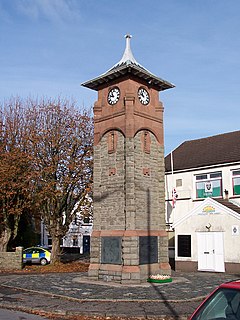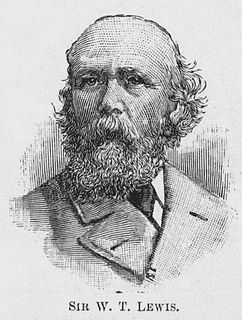Related Research Articles

Aberdare is a town in the Cynon Valley area of Rhondda Cynon Taf, Wales, at the confluence of the Rivers Dare (Dâr) and Cynon. Aberdare has a population of 39,550. Aberdare is 4 miles (6 km) south-west of Merthyr Tydfil, 20 miles (32 km) north-west of Cardiff and 22 miles (35 km) east-north-east of Swansea. During the 19th century it became a thriving industrial settlement, which was also notable for the vitality of its cultural life and as an important publishing centre.

Henry Austin Bruce, 1st Baron Aberdare was a British Liberal Party politician, who served in government most notably as Home Secretary (1868–1873) and as Lord President of the Council.

Merthyr Tydfil is the main town in Merthyr Tydfil County Borough, administered by Merthyr Tydfil County Borough Council. It is about 23 miles (37 km) north of Cardiff, Wales. Often called just Merthyr, it is said to be named after Tydfil, daughter of King Brychan of Brycheiniog, who according to legend was slain at Merthyr by pagans about 480 CE. Merthyr generally means "martyr" in modern Welsh, but here closer to the Latin martyrium: a place of worship built over a martyr's relics. Similar place names in south Wales are Merthyr Cynog, Merthyr Dyfan and Merthyr Mawr.

Henry Richard was a Congregational minister and Welsh Member of Parliament between 1868–1888. Richard was an advocate of peace and international arbitration, as secretary of the Peace Society for forty years (1848–1884). His other interests included anti-slavery work.

Hirwaun is a village and community at the north end of the Cynon Valley in the County Borough of Rhondda Cynon Taf, South Wales. It is 4 miles (6 km) NW of the town of Aberdare, and comes under the Aberdare post town. At the 2001 census, Hirwaun had a population of 4,851. increasing at the 2011 census to 4,990. The village is on the Heads of the Valleys Road and at the southern edge of the Brecon Beacons National Park.

Trecynon is a village near Aberdare situated in the Cynon Valley, in Rhondda Cynon Taf, Wales. It dates from the early nineteenth century and developed as a result of the opening of the Aberdare Ironworks at Llwydcoed in 1800.

Penywaun is a community, electoral ward and north-western suburb of Aberdare in the Cynon Valley within the county borough of Rhondda Cynon Taf, Wales. At the 2011 census, the population of the ward was registered as 3,063.
Merthyr Tydfil was a parliamentary constituency centred on the town of Merthyr Tydfil in Glamorgan. From 1832 to 1868 it returned one Member of Parliament (MP) to the House of Commons of the Parliament of the United Kingdom, and in 1868 this was increased to two members. The two-member constituency was abolished for the 1918 general election.

William Thomas Lewis, 1st Baron Merthyr, known as Sir William Lewis, 1st Baronet, from 1896 to 1911, was a Welsh coal mining magnate.
Thomas Price was a leading figure in the political and religious life of Victorian Wales and minister of Calfaria Baptist Chapel, Aberdare.

Calfaria Baptist Chapel, Aberdare, was one of the largest baptist churches in the South Wales Valleys and the oldest in the Aberdare valley. The chapel had an ornate interior, including a boarded ceiling with a deeply undercut rose, while the balcony balustrading had a cast iron front with an intricate foliage design. These features were common in the Welsh chapels of the late nineteenth century. The organ was installed in 1903 at a cost of £850. It was played for the last time in 2012 by Robert Nicholls, during a Radio Cymru broadcast shortly before the closure of the chapel.
David Davis, Blaengwawr, was a leading figure in the South Wales coal industry and a founder of the steam coal trade.

Siloa, Aberdare was the largest of the Welsh Independent, or Congregationalist, chapels in Aberdare. Services are held in the Welsh language. Established in 1844, Siloa is one of the few Welsh language chapels in the locality to remain open today. Siloa was notable for its long-serving ministers and in over a century there were only three pastorates, namely those of David Price (1843–78), D. Silyn Evans (1880–1930) and R. Ifor Parry (1933–64).
Aberdare Local Board of Health was established in 1854 in response to the 1848 Public Health Act, and a report on the sanitary condition of the town conducted by Thomas Webster Rammell. It was eventually replaced in 1894 by Aberdare Urban District Council.
The Aberdare strike of 1857–1858 was one of the first significant industrial disputes in the history of the steam coal trade of South Wales. The origins of the strike lay in the decision of the employers to impose a wage reduction of up to 20%, as a result of the general depression in trade in the aftermath of the Crimean War. During the dispute a trade union appeared amongst the miners of the Aberdare Valley but the men were ultimately forced to return to work on the terms set by the owners.
Nonconformity was a major religious movement in Wales from the 18th to the 20th centuries. The Welsh Methodist revival of the 18th century was one of the most significant religious and social movements in the modern history of Wales. The revival began within the Church of England in Wales, partly as a reaction to the neglect generally felt in Wales at the hands of absentee bishops and clergy. For two generations from the 1730s onwards the main Methodist leaders such as Howell Harris, Daniel Rowland and William Williams Pantycelyn remained within the Church of England, but the Welsh revival differed from the Methodist revival in England in that its theology was Calvinist rather than Arminian. Methodists in Wales gradually built up their own networks, structures, and meeting houses, which led, at the instigation of Thomas Charles, to the secession of 1811 and the formal establishment of the Calvinistic Methodist Presbyterian Church of Wales in 1823.
Owen Harris was a Liberal politician and municipal leader in Aberdare, South Wales.

Hen-Dy-Cwrdd is a disused Unitarian chapel in Trecynon, Aberdare, Wales. Services at the chapel were conducted in the Welsh language.

Charles Wilkins of Merthyr Tydfil, Glamorganshire, was a prolific writer of historical accounts of Wales and its industries. He produced pioneering reference works on the histories of Merthyr Tydfil and Newport; the coal, iron, and steel trades of South Wales; and Welsh literature. He was also founding editor of The Red Dragon: The National Magazine of Wales.

David Watkin Jones, also known by his bardic name Dafydd Morganwg(sic), was a Welsh poet, historian and geologist. He is remembered as the author of numerous works, especially Yr Ysgol Farddol, considered by many later poets as the main text for Welsh prosody.
References
- ↑ Wills 1969, p. 75.
- 1 2 "Death of the Rector of Merthyr". Aberdare Times. 2 May 1885. Retrieved 7 November 2013.
- 1 2 3 Wills 1969, p. 76.
- 1 2 3 4 5 6 Price, Watkin William. "John Griffith". Dictionary of Welsh Biography . National Library of Wales . Retrieved 7 November 2013.
- 1 2 3 Wills 1969, p. 77.
- ↑ Wills 1969, pp. 78–9.
- ↑ "1847 Report into the State of Education in Wales"., p.489
- ↑ "Correspondence". Cardiff and Merthyr Guardian. 26 February 1848. p. 4. Retrieved 20 November 2016.
- ↑ Wills. "John Griffith": 82–3.Cite journal requires
|journal=(help) - ↑ Wills 1969, p. 91.
- ↑ "The Funeral". Weekly Mail. 2 May 1885. Retrieved 7 November 2013.